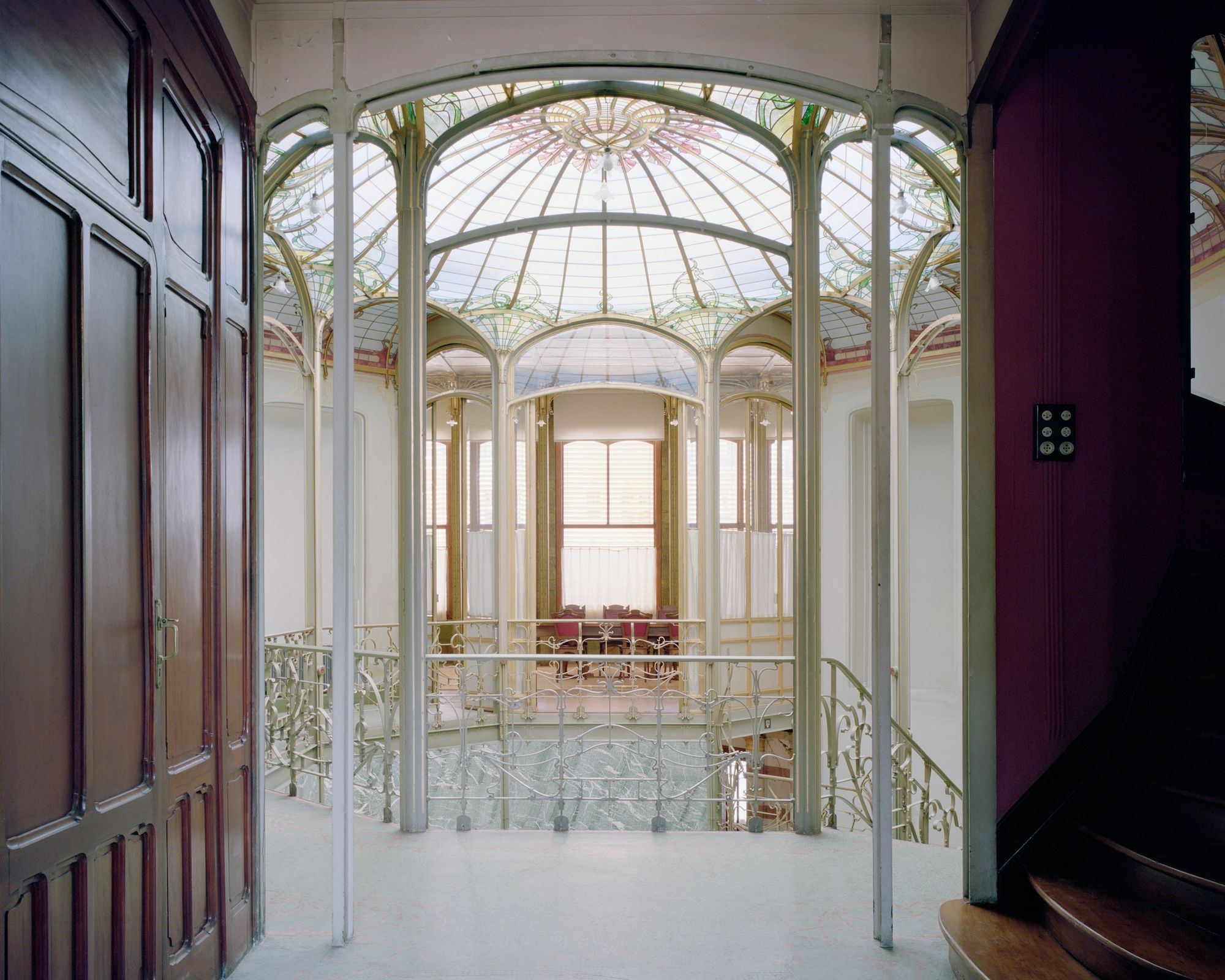DESIGN LEGENDS OCTOBER 19 2022
by Daniella Ohad
Design doyenne Daniella Ohad recaps her weekly conversations with the legends of architecture
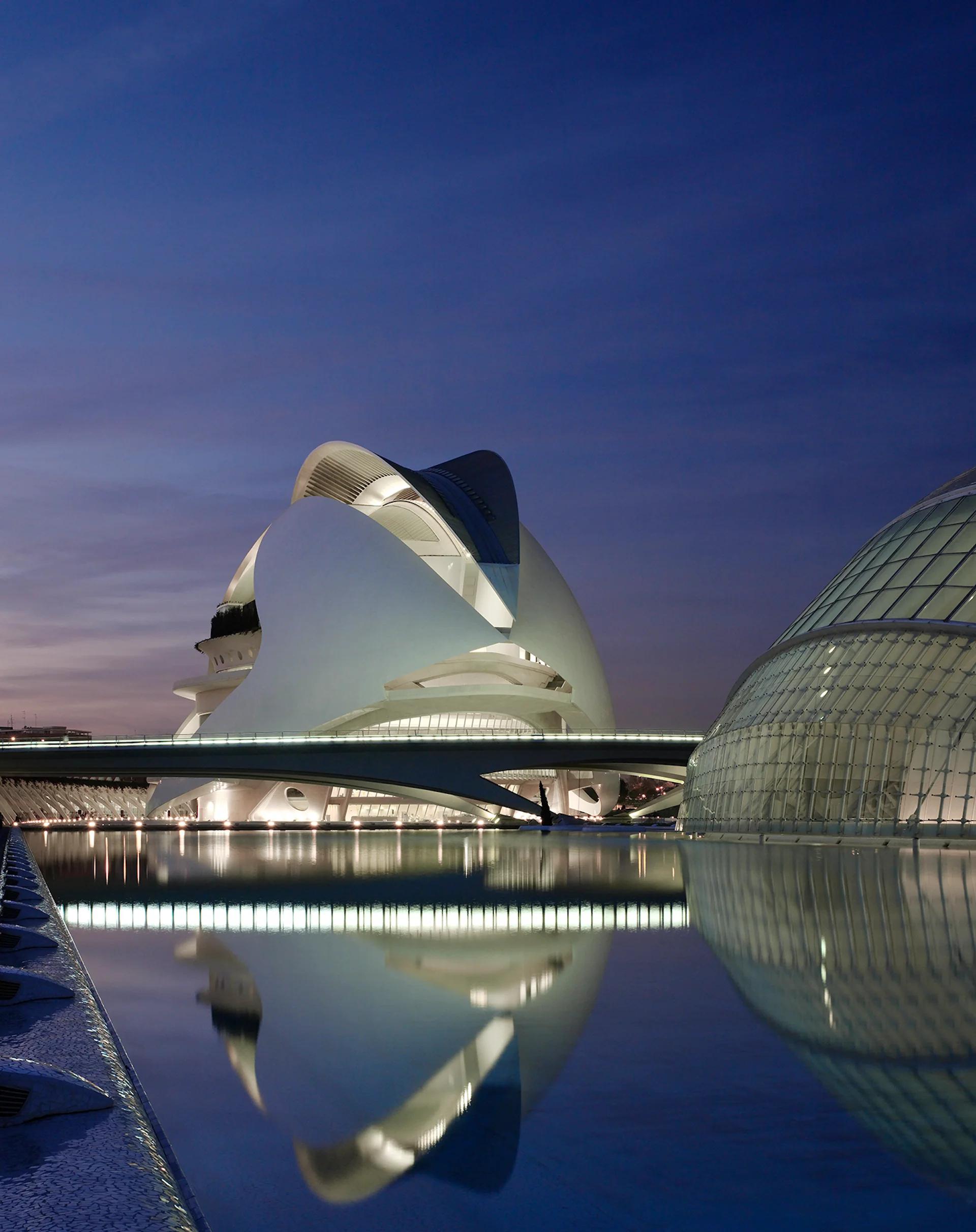
SANTIAGO CALATRAVA/ PALAU DE LES ARTS REINA SOFÍA, ONE BUILDING IN HIS CIUTAT DE LES ARTS I LES CIÈNCIES CULTURAL COMPLEX IN VALENCIA
Photo © Alan Karchmer / Otto
Each week this fall,Daniella Ohad hostsArchitecture: The Legends, a virtual program presented in partnership with Christie’s Education, comprising one-on-one interviews with the world’s most admired architects. For the Design Miami/ Forum, Ohad shares highlights from each conversation. This week her subject is Santiago Calatrava.
“In his writings, Mr. Calatrava talks at length about the movement of light and space in a building, and how that movement can have the power to ‘elevate all those who experience it.’ The Quadracci Pavilion at the Milwaukee Art Museum fills all who enter it with a feeling of pride, awe, and inspiration. The building has elevated our purpose as a Milwaukee institution, creating a truly iconic landmark that matches the museum’s enduring mission as a civic and cultural resource and has transformed the status of our city...” —Dr. Marcelle Polednik, Donna and Donald Baumgartner Director, Milwaukee Art Museum
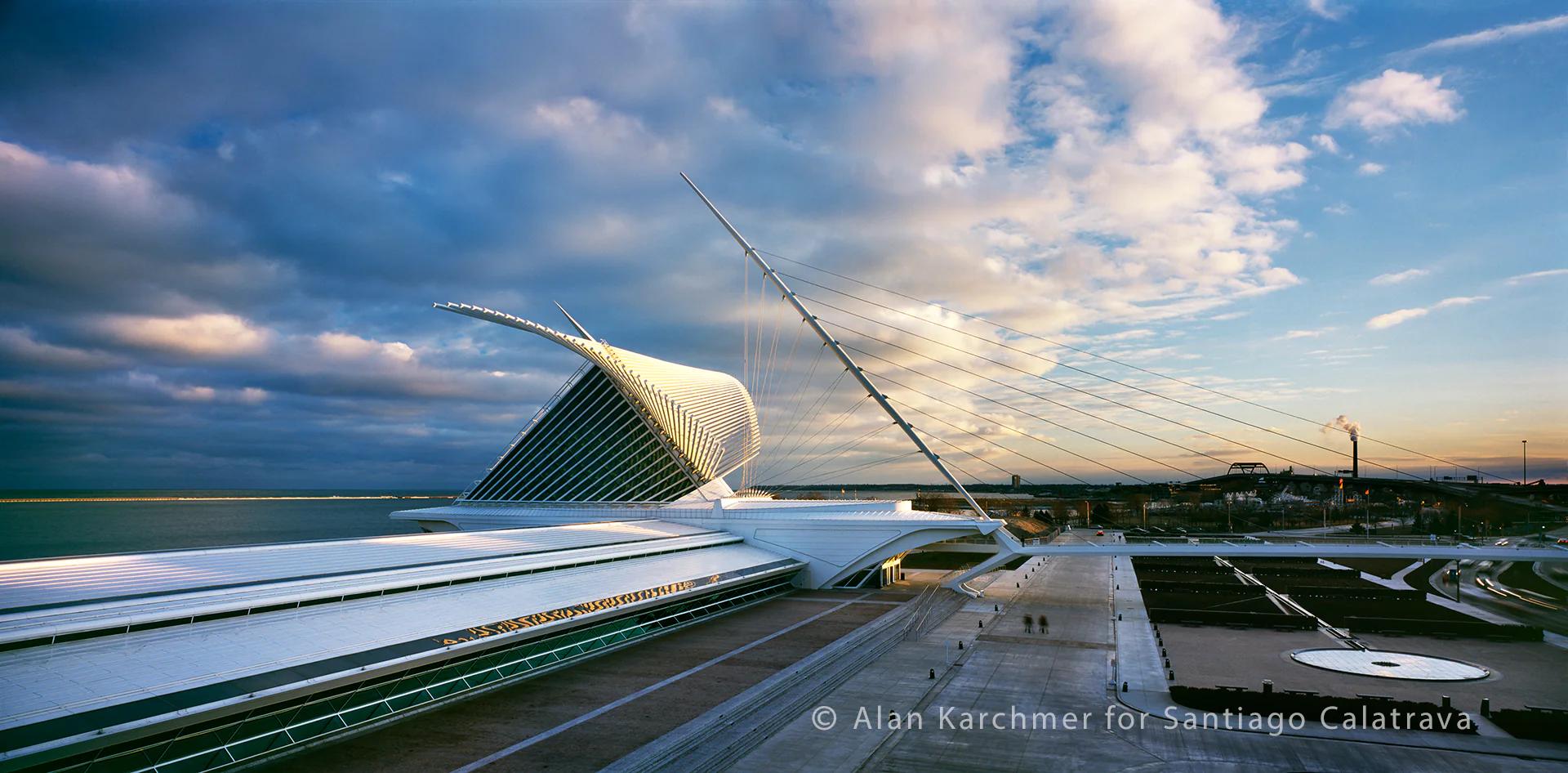
SANTIAGO CALATRAVA/ QUADRACCI PAVILION AT THE MILWAUKEE ART MUSEUM
Photo © Alan Karchmer / Otto
Architecture, according to Santiago Calatrava, cannot achieve greatness without projecting an emotional effect. During last week’s Architecture: The Legends program, the multi-award-winning Spanish-Swiss architect told us that the greatest architects reveal and express not only what is in their minds but also what is in their hearts, citing Oscar Niemeyer as the most outstanding architect of the 20th century and Louis Kahn’s Kimbell Art Museum as an example of architecture at its most sublime. What a privilege it was to hear one of the world’s most admired living architects share insights into how architectural experiences capture the zeitgeist.
For more than forty years, Calatrava has devoted his career to civic architecture and large-scale public projects, including bridges, airports, trains stations, concert halls, and museums. He has indelibly imprinted the character of cities around the globe through iconic spaces that are accessible to and loved by millions rather than reserved for only the privileged few.
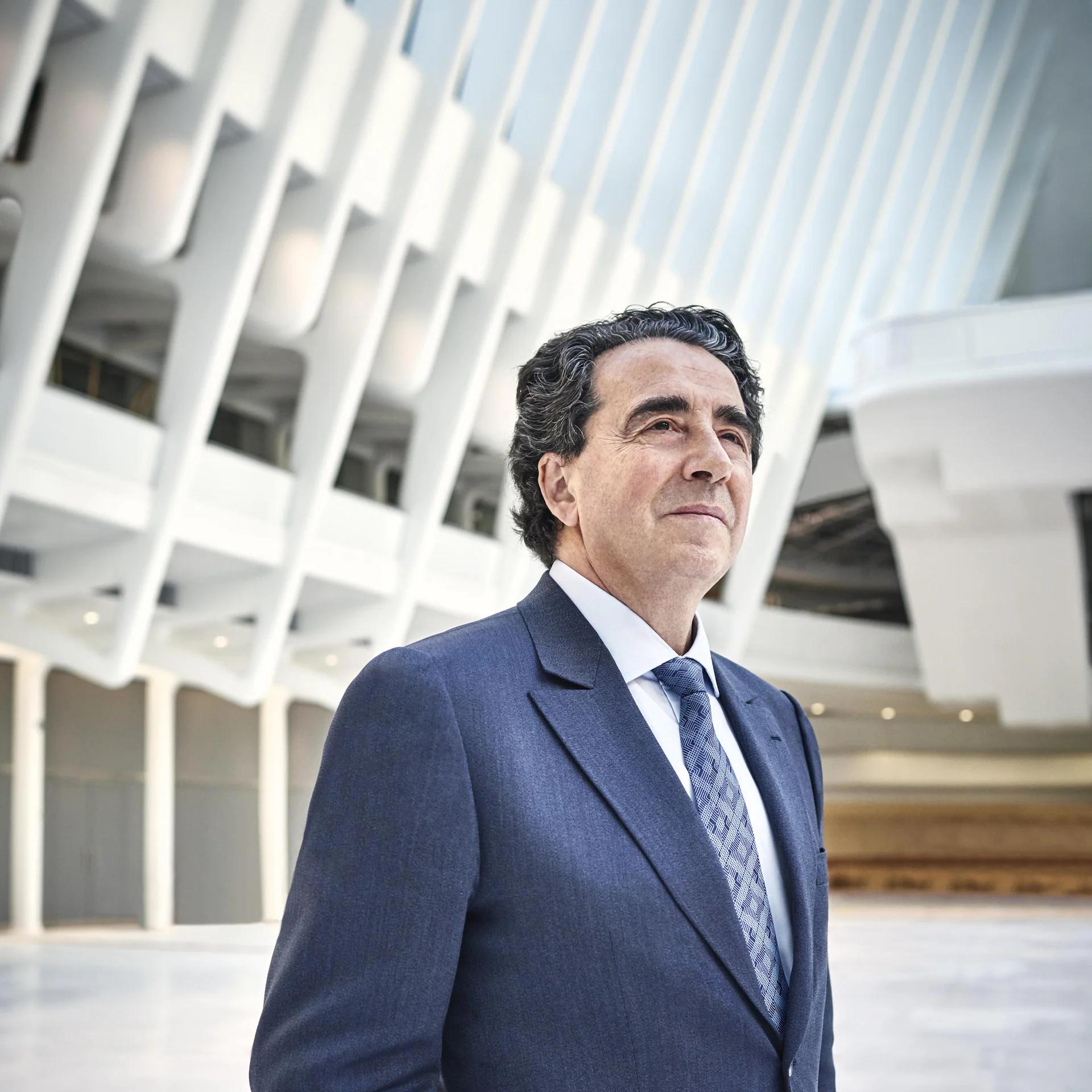
SANTIAGO CALATRAVA
Photo © Thomas Hoeffgen; courtesy of Santiago Calatrava LLC
A moment of spiritual enlightenment propelled Calatrava to pursue a career in architecture. At age 16, as an exchange student in Paris, he visited the Cathédrale Notre-Dame—one of the most beloved architectural structures of all time—and was struck by the transformative power of architecture to touch all of our senses and leave us indescribably moved. Perhaps this is why one of Calatrava’s favorite novels is The Hunchback of Notre-Dame by Victor Hugo, whose exquisite, passionate descriptions inspired generations of readers to idolize the 800-year-old marvel of Gothic architecture and champion its preservation.
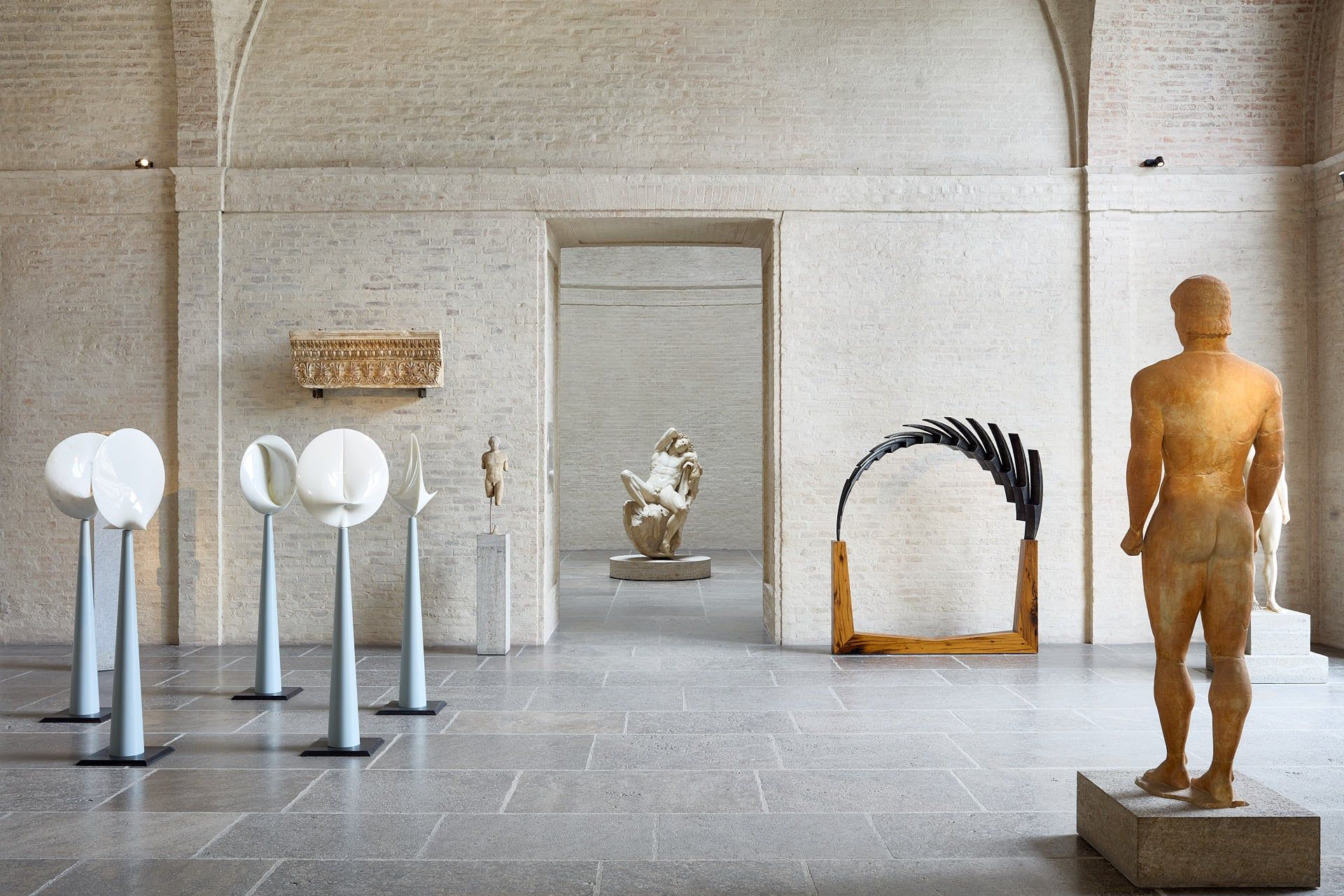
INSTALLATION VIEW OF BEYOND HELLAS: SANTIAGO CALATRAVA AT THE GLYPTOTHEK
Photo © Palladium Photodesign / Oliver Schuh + Barbara Burg

INSTALLATION VIEW OF BEYOND HELLAS: SANTIAGO CALATRAVA AT THE GLYPTOTHEK
Photo © Palladium Photodesign / Oliver Schuh + Barbara Burg
The point of departure for our conversation was Beyond Hellas: Santiago Calatrava, the exhibition of Calatrava’s Aegineten series currently in its last week at the Glyptothek in Munich. Encapsulating his ongoing quest to integrate art and architecture, the show presents Calatrava’s Temple of Aphaia-inspired artworks—works on paper and sculptures in produced over the last 30 years—displayed in conversation with the museum’s extensive collection of Greek and Roman antiquities and its temple-like, Neoclassical architecture.
Florian Knauß, Director of the Glyptothek, pointed out to me that “both the ancient Greek sculptures and Calatrava’s Aegineten series are governed by the tense interplay between burden and support,” adding that he hopes the show will bring renewed interest in “the masterpieces of sculpture displayed in Munich’s oldest museum.”
Creating art, Calatrava told us, is crucial to the evolution of his architecture. He starts his day, every day, working on his art in his home studio. He approaches his sculptures as exercises in structure, many of which he goes on to develop into architectural monuments.
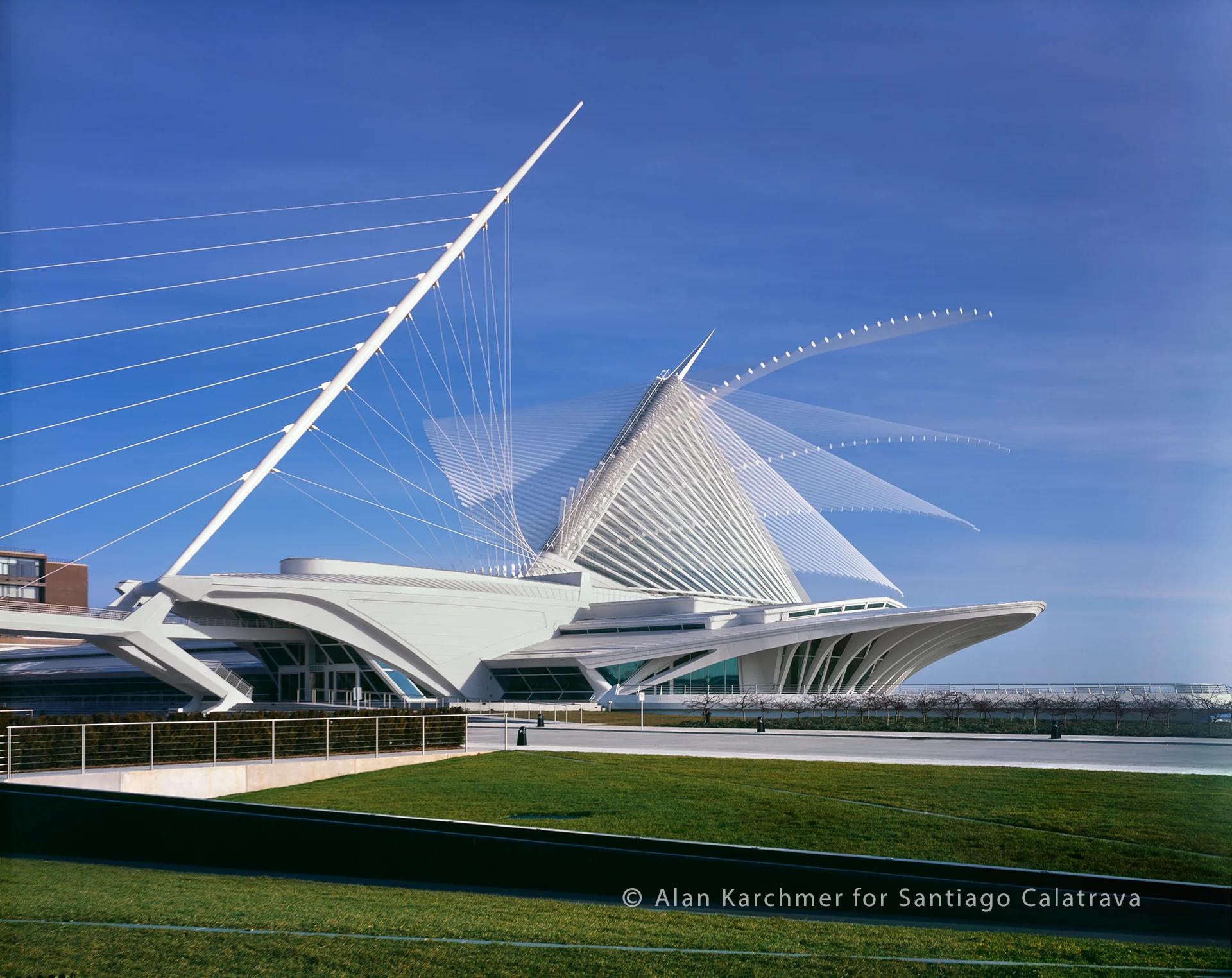
SANTIAGO CALATRAVA/ QUADRACCI PAVILION AT THE MILWAUKEE ART MUSEUM
Photo © Alan Karchmer / Otto
The emotive impact of Calatrava’s architecture was introduced to the US public with the inauguration of his Quadracci Pavilion for the Milwaukee Art Museum in 2001, just weeks after the tragic events of 9/11. In that moment, as Americans en masse were overwhelmed with sadness, fear, and anger, Calatrava’s sculptural, wing-like white structure on Lake Michigan fueled an atmosphere of pride and patriotism. Standing at the podium during its formal dedication, the design was, he said, a testimony to his love and admiration for America, the land of opportunity and hope, where people from all over the world—including himself—are able to materialize their ambitions and dreams; a place where diversity encourages greatness. “I hope,” he said, “we have designed not a building, but a piece of the city.” It instantly came to be seen as an emblem of optimism for a brighter future, and its architect a hero of Milwaukee.
With his Quadracci Pavilion, designed as an extension to the museum’s original, mid-century modernist concrete building by Eero Saarinen, Calatrava demonstrated his mastery of balancing the old with the new. Despite stylistic differences, the two buildings coexist in harmony with each other as well with the site’s landscape, the urban backdrop, and the serene horizon line visible across the lake.
“When we first embarked on the journey with Mr. Calatrava in 1994,” Marcelle Polednik, the museum’s director, told me, “we knew we’d be getting a beautiful structure, but what he really gifted us was a sense of hope, aspiration, and destiny for our community.” Named by Time Magazine the number one design of 2001, this superstructure with its motorized roof remains a vital touchstone for the city of Milwaukee, which recently designated September 16th as Santiago Calatrava Day.
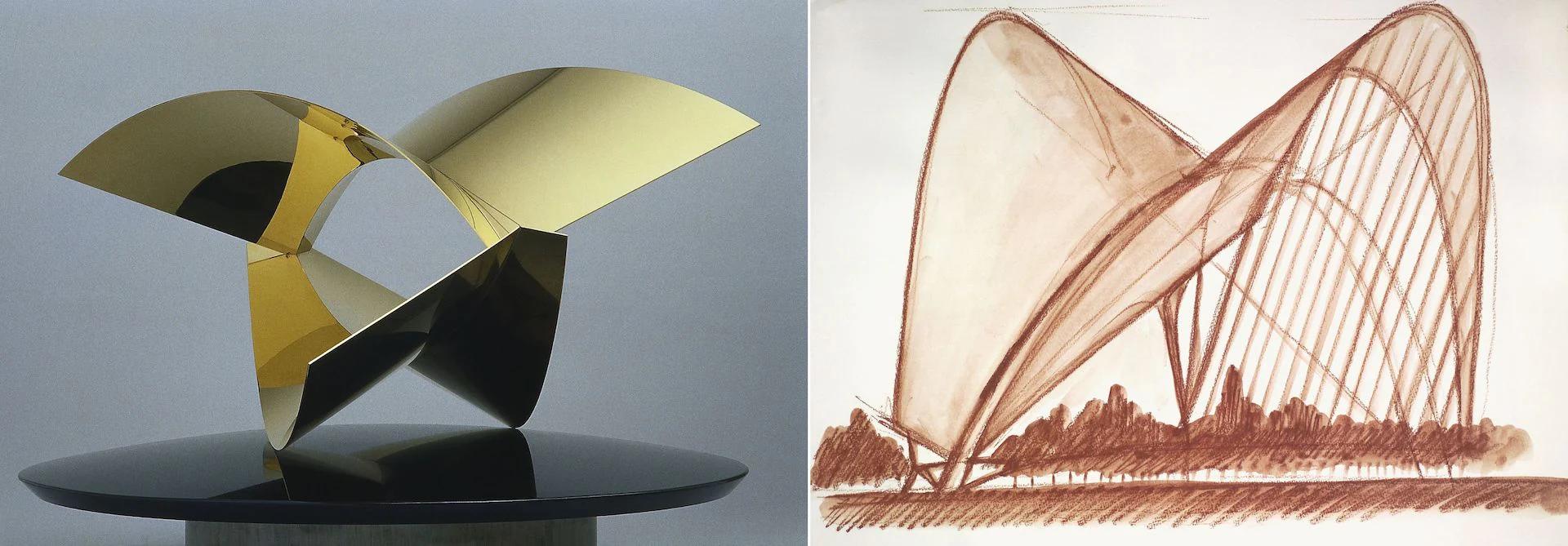
SANTIAGO CALATRAVA/ MOTHER AND CHILD SCULPTURE, 1990, AND OCULUS TRANSPORTATION HUB SKETCH
Photos © Santiago Calatrava LLC
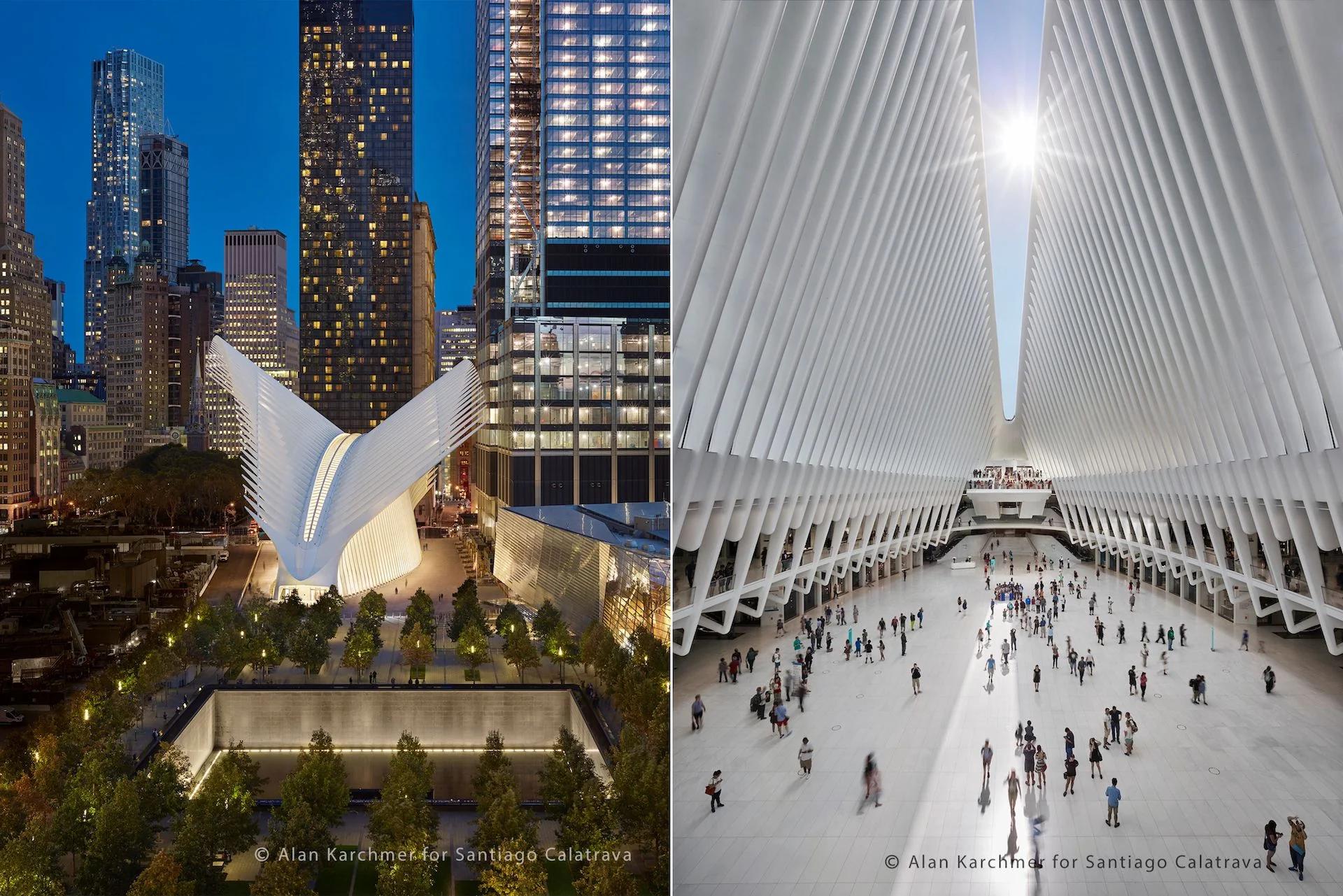
SANTIAGO CALATRAVA/ OCULUS TRANSPORTATION HUB AT THE WORLD TRADE CENTER IN NEW YORK CITY
Photos © Alan Karchmer / Otto
Iconic architecture frequently intersects with history. As Calatrava stood at that podium in Milwaukee in 2001, in the year of his 50th birthday, another landmark project would soon follow, arising from the New York’s determination to rebuild after the devastating terrorist attack on the Twin Towers. Calatrava’s Oculus Transportation Hub at the World Trade Center, modeled after his 1990 sculpture Mother and Child, is a feat of engineering that houses 12 subway lines while evoking a dove taking flight. Completed over 12 year from 2004 to 2016, it is the most ambitious and spectacular building in the Ground Zero ensemble. It made Calatrava a household name in the US and secured his place in the pantheon of starchitects who have defined the modern urban experience in this country. Like the Statue of Liberty and Empire State Building, this heroic, glowing, and flamboyant New York landmark attracts new admirers every day.
In our conversation, Calatrava praised Daniel Libeskind, who orchestrated the masterplan for Ground Zero. Their collaboration on the project was surely made easier by their many commonalities, from their mutual love for classical music to their shared status as foreigners contributing to the built environment and energy of New York City with hopes of transforming the darkness of tragedy into a beacon of light. The most humble of civil buildings, he told us, the train station should be celebrated as an engine of the city, standing at its heart and transforming the lives of millions. Making good train stations, he said, has become a lifelong mission.
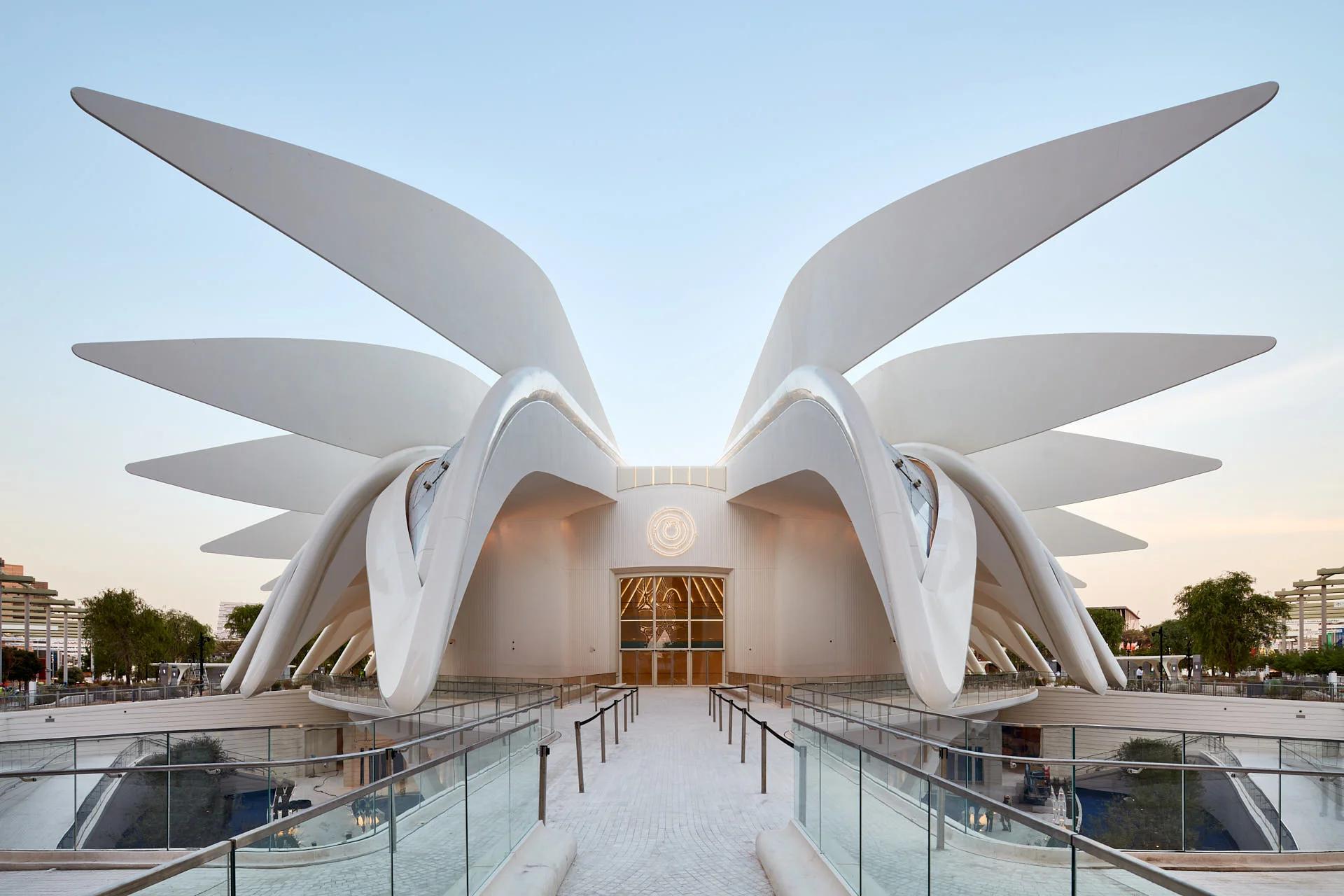
SANTIAGO CALATRAVA/ UAE PAVILION FOR DUBAI EXPO 2020
Photo © Palladium Photodesign / Oliver Schuh + Barbara Burg
For his UAE Pavilion for Dubai Expo 2020, the first world fair hosted in the Middle East, Calatrava gave the United Arab Emirates what he gave Milwaukee 20 years earlier. Inspired by the distinctive, raw landscape of the Arabian desert, he wanted to create a building that would capture the hearts and minds of the UAE people. Following delays due to the global pandemic, the resulting pavilion features a motorized roof that when open resembles a falcon in flight. It was an homage to the UAE’s national bird, a symbol of the nation’s strength and heritage, as well as an expression of the international zeitgeist longing for a post-pandemic vision.
While Calatrava has earned worldwide recognition as a master of public and passageway architecture, with high-profile architectural landmarks dotted around the globe, his own home looms large in his practice. When asked to identify his most important work to date, he named Valencia City of Arts and Sciences, the cultural complex he designed in the 1990s for his hometown. And as we talked through his many achievements, he made sure to credit his wife Robertina, calling her the ultimate partner in life and business whose respect and support has allowed him to pursue his passions and manifest his dreams. ◆
You can attend live Architecture: The Legends webinars by registeringhere. The program runs October-December, 2022.
Video of Santiago Calatrava's UAE Pavilion for Dubai Expo 2020 © Santiago Calatrava LLC, with aerial footage provided by UAE Pavilion team at Expo 2020.


